A Perverted Guide to Watching Under the Radar
1.
I’ve got a game. Ready?
You pick three people, or objects, or places, or concepts, and place each of them in the following categories—
- Chuck: You get rid of immediately
- Fuck: You have a short period of wild passion and never to meet again
- Marry: You spend the rest of your life with it but will never experience it fully
So the picks for this road-trip game can range from movie stars: Marilyn Monroe/Natalie Wood/Grace Kelly, to political leaders: Chairman Mao/Henry Kissinger/Mikhail Gorbachev, to my all time favorite: Electricity/Originality/Authenticity. Indulge me and think about this with respect to theater and theater-making.
Electricity—technologically sophisticated, a theatrical spectacle, decibel or wattage heavy, virtuosic performance, etc.
Originality—defining a new aesthetic, creating a new form or performance style, reinventing of site/context, etc.
Authenticity—performer as performer, documentary text, durational performance, embodiment and presence, the presentational, lack of artifice, anti-theatricality, etc.
Undoubtedly, the associations with these categories are unabashedly subjective. But go on. Play chuck fuck marry. I dare you. If you had to strip away everything and define your priorities—what would you get rid of if you were forced to? What would carry you through to the end of your practice?
2.
I have been thinking about theater in these three categories, and I go through phases in which one seems to take precedence and priority over the others, both in the watching, and the making. You can’t actually do all three fully. It approaches a zero-sum game when one has to choose due to limited resources, be it time, space, focus.
One can hardly divorce oneself from thinking about authenticity nowadays, whether in art (Please note the recent excellent articles by Andy Horwitz of Culturebot and Claire Bishop in the Brooklyn Rail) or political practice. I am writing this at the end of 2011—a momentous year of protest and action, both humbling and astonishing to me. When confronted with the fact that people in the world are making real and hard choices to effect actual change, sometimes theater can seem rather...in the rear view mirror. Then the crisis of faith fades a little, and I think—if you are going to do theater, you just better be fucking real about it.
At Under the Radar, we have consistently presented artists who pivot their practice on this notion of the real including Richard Maxwell (the affect-less performer), Vivarium Studio/Phillippe Quesne (an exceptionally detailed mise-en-scène), Tim Crouch (the unrehearsed performer). Other artists probe the idea of using “real people” as unexpected performers: Australia’s Back to Back Theatre (people with perceived disabilities), Rotozaza (the audience itself), Doris Mirescu (mix of professional and amateur performers), and Ontroerend Goed (tweenagers).
What is the value of the real? Why are these twenty-first century artists trying to strip away artifice? I’ve been trying to read Slavoj Žižek’s, Interrogating the Real, and feeling like a bit of a dunce. But the sentence that I keep circling back to is this: “The ‘real’ in the Lacanian sense: the construction of a point which effectively does not exist, but which, nonetheless, must be presupposed in order to justify our negative reference to the other.” If we shift this sentence to a theater context—what does it mean to construct the real? What is the fantasy that we are fabricating to point to the real? How does fiction find authenticity? Are authentic and real the same thing? How do we use our theater to interrogate the real/truth/reality?
What does it mean to construct the real? What is the fantasy that we are fabricating to point to the real?
With the Under the Radar opening on January 4, here are a few thoughts transposed upon a few of the festival presentations.
3.
The search for authentic fictions
An authentic feeling can be associated with a “fraudulent,” fictitious story and even one that is easy to see through. The feeling is important and authentic, even when we are conscious of the mechanisms that gave rise to it. In this way truth and fiction can be indistinguishable. We no longer consider them to be relevant categories. In our projects, we are on the hunt for authentic fictions. (Gob Squad Reader)
In Gob Squad’s work, fact and fiction are inextricably linked. In Super Night Shot, the performers go out into the city to confront reality with a pronounced fiction—to create a hero’s journey. Waging a “war against anonymity,” Gob Squad goes into the streets armed with four video cameras, and recruits passersby to play roles in their shows and be part of the fiction. They become lovers, enemies, witnesses of the performers. Because these people are interrupted from their daily routine in the street in the real world, and not invited from within the contexts and expectations of a theater, they participate more freely, and are therefore, more real. In an encounter that is both contrived and true—a performer and a passerby talk about love and kiss while a beautiful pop song plays. You find yourself giving over to this “authentic fiction” and your heart swells a little.
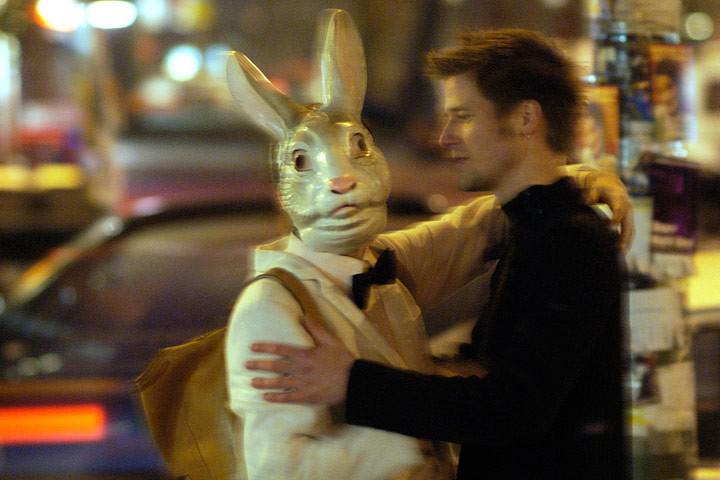
Gob Squad collides the performative act into the outside world—with excess, with banality, with beauty. By placing in parallel the Hollywood epic and extravagant gestures with the ordinary city streets and daily patterns, they disrupt the rhythms and reframe the perception of real time and real space. As in their other pieces, they look at present realities like an artifact to be reexamined, reframed, and remixed.
Showing the wires and the strings Can puppets be real? Do they have souls?
The Table by Blind Summit is about a three-man operated Bunraku puppet, constructed from cardboard boxes, having an existential crisis. You see a puppet self-destruct and deconstructed in front of your very eyes. But can a puppet be read as authentic? More “real” than a human?
Absolutely. Puppetry strips away artifice through creating artifice. When puppets really work, with all the wires and strings hanging out, it is because somehow the audience’s mind has been retooled to suspend disbelief. I imagine a Super 8 projector that is placed on my forehead and the puppet is the projection surface. The image and narrative that is projected upon this emphatically constructed puppet form is all the more vivid and complex because of the chasm present between reality and fiction.
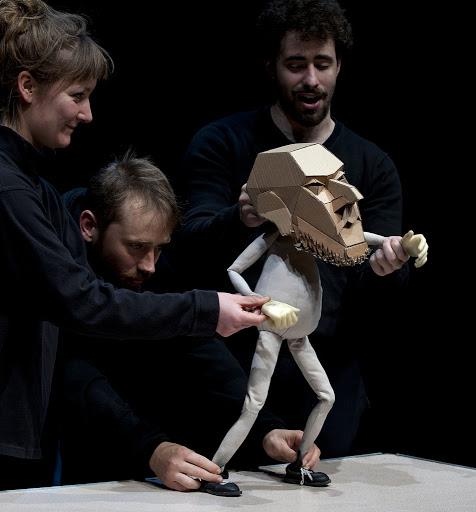
A common approach to contemporary theater is to acknowledge the present constructs as a first step towards defining a new reality. In Heinrich von Kleist’s On the Marionette Theatre, his friend discusses his newfound respect for marionettes.
The advantage? First of all a negative one, my friend: it would never be guilty of affectation. For affectation is seen, as you know, when the soul, or moving force, appears at some point other than the centre of gravity of the movement. Because the operator controls with his wire or thread only this centre, the attached limbs are just what they should be.…lifeless, pure pendulums, governed only by the law of gravity. This is an excellent quality. You'll look for it in vain in most of our dancers.
I love the idea of the soul having to be at the center of gravity of the movement. My favorite moments in theater have always been when the performer gives over to the center of gravity of the movement —a pure pendulum, swinging from moment to moment. When bound to gravitational forces, whether the pendulum’s arc is wide (a performer trying to race between tasks, focused and sweating), or narrow (a performer at neutral, ready for minute stimuli), it creates the potential for that rare moment to be free of affectation and pretense.
(Up)staging the hyperreal
This past April, I sat in at an early rehearsal of Pig Iron and Toshiki Okada’s first collaboration—Zero Cost House —at a residency at Playmakers Repertory. Toshiki Okada is the Japanese writer and director who has been making waves in the international theater circuit with his company chelfitsch for his juxtaposition of hyperreal, hyper-colloquial, hyper-inarticulate language of the twenty-something generation in Japan with an extreme choreography that has been teased out from mundane everyday gestures. With Hot Pepper, Air Conditioner and Farewell Speech he transforms office conversations and water-cooler talk into a small poetic tragedy of the everyday. The details are minute and seemingly trivial—the temperature of the office, where to take a co-worker to a farewell dinner, getting ready for the workday. These circular confabulations grow and pulsate, thrown into stark relief by the angular and repetitive choreography. This is as close to free jazz as theater gets.

Back to the rehearsal. Okada (who spoke Japanese and was assisted by a translator) asked the actors to describe a scene in a particular chapter from Thoreau’s Walden, asking them to place the image, as fully as possible, in the audience’s mind. In the process, they kept stripping away the “performance” aspect and concentrated in the transmission of the image. I may be making up the numbers but it is 10 percent actor performing, 90 percent in the audience’s mind. The image and narrative plays in an audience member’s own head—unique, unreplicable, and authentic.
The parallels between Okada’s “transmission of image,” and Richard Maxwell’s work in neutrality and presentational aesthetics was really interesting to me. Maxwell’s work is based on the strident reality that we are watching a theater performance. There is no point in pretending it is anything else. There is no point in pretending. The company’s work strives for a pure form. The language is neutral. The performance is neutral, offered to the audience to create their own play in their head—unique, unreplicable, and authentic.
Based on a true story With Motus’s Alexis. A Greek Tragedy, the Italian company continues their investigation of revolution and youth as part of their Antigone trilogy. They went to Athens in search of a living Antigone: following the trail of the ancient Antigone myth, as well as the 2008 police shooting of a fifteen-year-old boy Alexis and the violent city-wide uprising that followed. Weaving documentary theater techniques with scenes of staggering theatricality, their presence feels at once authentic and performative. They use recordings from their research visits, video fragments from the web, testimonies, dialogue between actors and their characters, and situate it in a theatrical atmosphere that glows and pulsates. They are theatrical archeologists excavating the real, and simultaneously commenting on their findings.
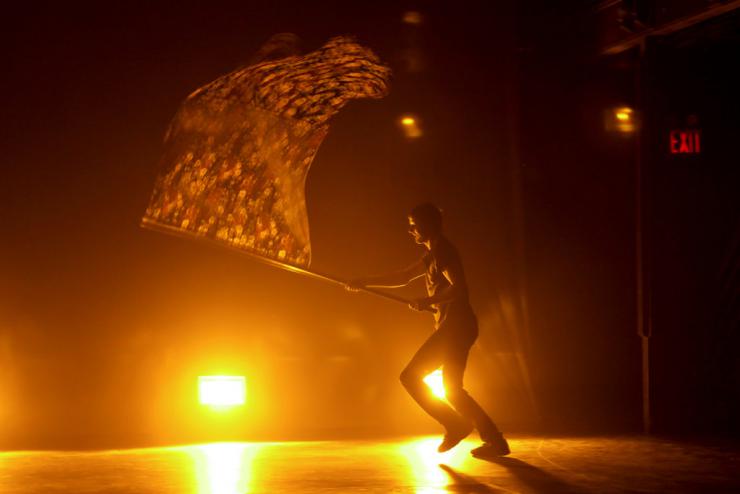
Silvia Calderoni (Antigone) discusses with Benno Steinneger (Polynices) her technique—both technical and physical:
Silvia: When you’re weeping over a body on stage—and you have a radio microphone—if you put your cheek to the breast of the other actor you create a sound box between the two bodies…it works a bit like a piano… Benno: So it’s my body that amplifies your crying… Silvia: Yes, that’s more or less how it is: “My brother, beloved above all others, you died to live better, you’ve killed me too with your death.” And then I usually stiffen my arms and legs, so mine is physical crying, I close my eyes and when I open them I see you on the ground with your eyes closed… and I start crying… Benno: And there, at that moment, it’s hard not to embrace you…
As performers, they acknowledge the artifice of the construct, the stage, the play. They step in and out of the reality of “making a play” and the fiction. They perform scenes from Antigone. They talk directly to the audience. They ask each other questions. Distinguishing lines between performer and character dissolve—Antigone and Silvia both wonder if it’s too late for change and revolution. Both describe the difficulty of acting and action. By acknowledging the artificiality of the construct—and the similar ache for change—one leans a little closer to hear them tell the truth.
4.
After watching Zizek’s A Pervert’s Guide to Cinema, a strange and glorious BBC documentary where Zizek unpacks the history of cinema in terms of Lacanian psychoanalysis, this weird diagram has been floating in my mind. Meditating on that diagram, those individual spheres come in and out of focus, insisting on their own scrutiny. Let’s face it. Nothing is actually real. As Guy Debord says, “In societies where modern conditions of production prevail, all of life presents itself as an immense accumulation of spectacles. Everything that has lived has moved away into a representation.” Saying “Yes, I know I am performing but it’s okay because I acknowledge it” just removes a particular layer of artifice to reveal another. There are other shows at UTR that repel “realness.” There are shows where the pleasure of an elaborate mise-en-scene is unreservedly satisfying, where actors give transformative, exhilarating character performances, and where unnatural, ear-pounding electronic punk makes your heart beat a little faster.
That works for me too.
5.
So, perhaps we can meet up at Under the Radar. See a few shows. Have a drink at the festival lounge. And we can gather some folks to play a late night game of chuck fuck marry.





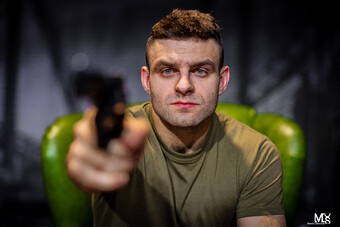

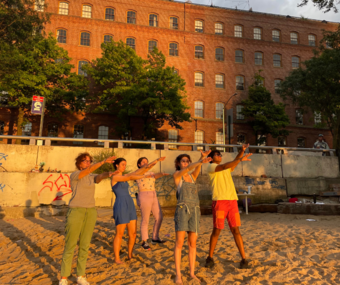

Comments
The article is just the start of the conversation—we want to know what you think about this subject, too! HowlRound is a space for knowledge-sharing, and we welcome spirited, thoughtful, and on-topic dialogue. Find our full comments policy here